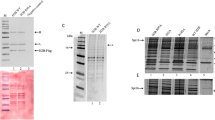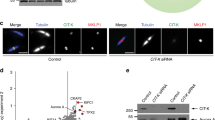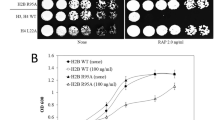Abstract
Although scaffolding is a major regulator of mitogen-activated protein kinase (MAPK) pathways, scaffolding proteins are poorly understood. During yeast mating, MAPK Fus3p is phosphorylated by MAPKK Ste7p, which is activated by MAPKKK Ste11p. This MAPK module interacts with the scaffold molecule Ste5p. Here we show that Ste11p and Ste7p were predominantly cytoplasmic proteins, while Ste5p and Fus3p were found in the nucleus and the cytoplasm. Ste5p, Ste7p and Fus3p also localized to tips of mating projections in pheromone-treated cells. Using fluorescence recovery after photobleaching (FRAP), we demonstrate that Fus3p rapidly shuttles between the nucleus and the cytoplasm independently of pheromones, Fus3p phosphorylation and Ste5p. Membrane-bound Ste5p can specifically recruit Fus3p and Ste7p to the cell cortex. Ste5p remains stably bound at the plasma membrane, unlike activated Fus3p, which dissociates from Ste5p and translocates to the nucleus.
This is a preview of subscription content, access via your institution
Access options
Subscribe to this journal
Receive 12 print issues and online access
$209.00 per year
only $17.42 per issue
Buy this article
- Purchase on Springer Link
- Instant access to full article PDF
Prices may be subject to local taxes which are calculated during checkout






Similar content being viewed by others
References
Cobb, M. H. MAP kinase pathways. Prog. Biophys. Mol. Biol. 71, 479–500 (1999).
Whitmarsh, A. J. & Davis, R. J. Structural organization of MAP-kinase signalling modules by scaffold proteins in yeast and mammals. Trends Biochem. Sci. 23, 481–485 (1998).
Schaeffer, H. J. & Weber, M. J. Mitogen-activated protein kinases: specific messages from ubiquitous messengers. Mol. Cell Biol. 19, 2435–2444 (1999).
Elion, E. A. Pheromone response, mating and cell biology. Curr. Opin. Microbiol. 3, 573–581 (2000).
Dohlmanm, H. & Thorner, J. Regulation of G protein-initiated signal transduction in yeast: paradigms and principles. Annu. Rev. Biochem. 70, 703–754 (2001).
Whiteway, M. S. et al. Association of the yeast pheromone response G protein beta gamma subunits with the MAP kinase scaffold Ste5p. Science 269, 1572–1575 (1995).
Leeuw, T. et al. Interaction of a G-protein beta-subunit with a conserved sequence in Ste20/PAK family protein kinases. Nature 391, 191–195 (1998).
Choi, K. Y., Satterberg, B., Lyons, D. M. & Elion, E. A. Ste5 tethers multiple protein kinases in the MAP kinase cascade required for mating in S. cerevisiae. Cell 78, 499–512 (1994).
Kranz, J. E., Satterberg, B. & Elion, E. A. The MAP kinase Fus3 associates with and phosphorylates the upstream signalling component Ste5. Genes Dev. 8, 313–327 (1994).
Marcus, S., Polverino, A., Barr, M. & Wigler, M. Complexes between STE5 and components of the pheromone-responsive mitogen-activated protein kinase module. Proc. Natl Acad. Sci. USA 91, 7762–7766 (1994).
Cook, J. G., Bardwell, L., Kron, S. J. & Thorner, J. Two novel targets of the MAP kinase Kss1 are negative regulators of invasive growth in the yeast Saccharomyces cerevisiae. Genes Dev. 10, 2831–2848 (1996).
Tedford, K., Kim, S., Sa, D., Stevens, K. & Tyers, M. Regulation of the mating pheromone and invasive growth responses in yeast by two MAP kinase substrates. Curr. Biol. 7, 228–238 (1997).
Gustin, M. C., Albertyn, J., Alexander, M. & Davenport, K. MAP kinase pathways in the yeast Saccharomyces cerevisiae. Microbiol. Mol. Biol. Rev. 62, 1264–1300 (1998).
Levin, D. E. & Errede, B. The proliferation of MAP kinase signalling pathways in yeast. Curr. Opin. Cell Biol. 7, 197–202 (1995).
Posas, F. & Saito, H. Osmotic activation of the HOG MAPK pathway via Ste11p MAPKKK: scaffold role of Pbs2p MAPKK. Science 276, 1702–1705 (1997).
Madhani, H. D. & Fink, G. R. The riddle of MAP kinase signalling specificity. Trends Genet. 14, 151–155 (1998).
Ferrigno, P., Posas, F., Koepp, D., Saito, H. & Silver, P. A. Regulated nucleo/cytoplasmic exchange of HOG1 MAPK requires the importin beta homologs NMD5 and XPO1. EMBO J. 17, 5606–5614 (1998).
Peter, M., Neiman, A. M., Park, H. O., vanLohuizen, M. & Herskowitz, I. Functional Analysis of the interaction between the small GTP-binding protein Cdc42 and the Ste20 protein kinase in yeast. EMBO J. 15, 7046–7059 (1996).
Leberer, E. et al. Functional characterization of the Cdc42p-binding domain of yeast Ste20p protein kinase. EMBO J. 16, 83–97 (1997).
Pryciak, P. M. & Huntress, F. A. Membrane recruitment of the kinase cascade scaffold protein Ste5 by the G beta gamma complex underlies activation of the yeast pheromone response pathway. Genes Dev. 12, 2684–2697 (1998).
Mahanty, S. K., Wang, Y., Farley, F. W. & Elion, E. A. Nuclear shuttling of yeast scaffold Ste5 is required for its recruitment to the plasma membrane and activation of the mating MAPK cascade. Cell 98, 501–512 (1999).
Choi, K. Y., Kranz, J. E., Mahanty, S. K., Park, K. S. & Elion, E. A. Characterization of Fus3 localization: active Fus3 localizes in complexes of varying size and specific activity. Mol. Biol. Cell 10, 1553–1568 (1999).
Khokhlatchev, A. V. et al. Phosphorylation of the MAP kinase ERK2 promotes its homodimerization and nuclear translocation. Cell 93, 605–615 (1998).
Adachi, M., Fukuda, M. & Nishida, E. Two co-existing mechanisms for nuclear import of MAP kinase: passive diffusion of a monomer and active transport of a dimer. EMBO J. 18, 5347–5358 (1999).
Gaits, F., Degols, G., Shiozaki, K. & Russell, P. Phosphorylation and association with the transcription factor Atf1 regulate localization of Spc1/Sty1 stress-activated kinase in fission yeast. Genes Dev. 12, 1464–1473 (1998).
Mattison, C. P. & Ota, I. M. Two protein tyrosine phosphatases, Ptp2 and Ptp3, modulate the subcellular localization of the Hog1 MAP kinase in yeast. Genes Dev. 14, 1229–1235 (2000).
Fukuda, M., Gotoh, Y. & Nishida, E. Interaction of MAP kinase with MAP kinase kinase: its possible role in the control of nucleocytoplasmic transport of MAP kinase. EMBO J. 16, 1901–1908 (1997).
Inouye, C., Dhillon, N., Durfee, T., Zambryski, P. C. & Thorner, J. Mutational analysis of STE5 in the yeast Saccharomyces cerevisiae: application of a differential interaction trap assay for examining protein-protein interactions. Genetics 147, 479–492 (1997).
White, J. & Stelzer, E. Photobleaching GFP reveals protein dynamics inside live cells. Trends Cell Biol. 9, 61–65 (1999).
Gorlich, D. & Kutay, U. Transport between the cell nucleus and the cytoplasm. Annu. Rev. Cell Dev. Biol. 15, 607–660 (1999).
Blondel, M. et al. Nuclear export of Far1p in response to pheromones requires the export receptor Msn5p/Ste21p. Genes Dev. 13, 2284–2300 (1999).
Oehlen, B. & Cross, F. R. Signal transduction in the budding yeast Saccharomyces cerevisiae. Curr. Opin. Cell Biol. 6, 836–841 (1994).
Gartner, A., Nasmyth, K. & Ammerer, G. Signal transduction in Saccharomyces cerevisiae requires tyrosine and threonine phosphorylation of FUS3 and KSS1. Genes Dev. 6, 1280–1292 (1992).
van Drogen, F., O'Rourke, S., Stucke, V., Jaquenoud, M. & Peter, M. Phosphorylation of the MEKK Ste11p by the PAK-like kinase Ste20p is required for MAP kinase signalling in vivo. Curr. Biol. 10, 630–639 (2000).
Doi, K. et al. MSG5, a novel protein phosphatase promotes adaptation to pheromone response in S. cerevisiae. EMBO J. 13, 61–70 (1994).
Garrison, T. R. et al. Feedback phosphorylation of an RGS protein by MAP kinase in yeast. J. Biol. Chem. 274, 36387–36391 (1999).
Sharrocks, A. D., Yang, S. H. & Galanis, A. Docking domains and substrate-specificity determination for MAP kinases. Trends Biochem. Sci. 25, 448–453 (2000).
Sette, C., Inouye, C. J., Stroschein, S. L., Iaquinta, P. J. & Thorner, J. Mutational analysis suggests that activation of the yeast pheromone response mitogen-activated protein kinase pathway involves conformational changes in the Ste5 scaffold protein. Mol. Biol. Cell 11, 4033–4049 (2000).
Feng, Y., Song, L. Y., Kincaid, E., Mahanty, S. K. & Elion, E. A. Functional binding between Gβ and the LIM domain of Ste5 is required to activate the MEKK Ste11. Curr. Biol. 8, 267–278 (1998).
Moskow, J. J., Gladfelter, A. S., Lamson, R. E., Pryciak, P. M. & Lew, D. J. Role of Cdc42p in pheromone-stimulated signal transduction in Saccharomyces cerevisiae. Mol. Cell Biol. 20, 7559–7571 (2000).
Reiser, V., Salah, S. M. & Ammerer, G. Polarized localization of yeast Pbs2 depends on osmostress, the membrane protein Sho1 and Cdc42. Nature Cell Biol. 2, 620–627 (2000).
Raitt, D. C., Posas, F. & Saito, H. Yeast Cdc42 GTPase and Ste20 PAK-like kinase regulate Sho1-dependent activation of the Hog1 MAPK pathway. EMBO J. 19, 4623–4631 (2000).
Guthrie, C. & Fink, G. R. Guide to Yeast Genetics and Molecular Biology (Academic, San Diego, 1991)).
Ausubel, F. M. et al. Current Protocols in Molecular Biology (Greene and Wiley-Interscience, New York, 1991).
Jaquenoud, M., Gulli, M. P., Peter, K. & Peter, M. The Cdc42p effector Gic2p is targeted for ubiquitin-dependent degradation by the SCFGrr1 complex. EMBO J. 17, 5360–5373 (1998).
Valtz, N. & Peter, M. Functional analysis of FAR1 in yeast. Methods Enzymol. 283, 350–365 (1997).
Brown, J. L., Jaquenoud, M., Gulli, M. P., Chant, J. & Peter, M. Novel Cdc42-binding proteins Gic1 and Gic2 control cell polarity in yeast. Genes Dev. 11, 2972–2982 (1997).
Gulli, M. et al. Phosphorylation of the Cdc42 exchange factor Cdc24 by the PAK-like kinase Cla4 may regulate polarized growth in yeast. Mol. Cell 6, 1155–1167 (2000).
Ellenberg, J. & Lippincott-Schwartz, J. in Cells: A Laboratory Manual (eds Spector, D., Goldman, R. & Leinwand, L.) 79.1–79.23 (Cold Spring Harbor Laboratory Press, 1998).
Acknowledgements
We thank P. Pryciak, G. Ammerer, M. Tyers, P. Nurse and E. Leberer for providing plasmids, strains and antibodies, and J. Ellenberger for helpful suggestions about FRAP and FLIP. We are grateful to T. Laroche and M. Allegrini for help with microscopy, N. Perrinjaquet for expert technical assistance, members of the group for stimulating discussion, and R. Iggo and P. Gönczy for critical reading of the manuscript. M.P. is supported by the Swiss National Science Foundation, the Swiss Cancer League and a Helmut Horten Incentive Award.
Author information
Authors and Affiliations
Supplementary information
Supplementary figures and tables
Figure S1 Nuclear transport of Fus3p–GFP in wild-type cells as assayed by FRAP does not change within 2 h after addition of α-factor. (PDF 241 kb)
Figure S2 Expression of the GFP-tagged proteins does not interfere significantly with pheromone signalling when expressed in wild-type cells.
Supplementary tables
Rights and permissions
About this article
Cite this article
van Drogen, F., Stucke, V., Jorritsma, G. et al. MAP kinase dynamics in response to pheromones in budding yeast. Nat Cell Biol 3, 1051–1059 (2001). https://doi.org/10.1038/ncb1201-1051
Received:
Revised:
Accepted:
Published:
Issue Date:
DOI: https://doi.org/10.1038/ncb1201-1051
This article is cited by
-
ASF1 regulates asexual and sexual reproduction in Stemphylium eturmiunum by DJ-1 stimulation of the PI3K/AKT signaling pathway
Fungal Diversity (2023)
-
Feed-forward regulation adaptively evolves via dynamics rather than topology when there is intrinsic noise
Nature Communications (2019)
-
Insights into regulatory roles of MAPK-cascaded pathways in multiple stress responses and life cycles of insect and nematode mycopathogens
Applied Microbiology and Biotechnology (2019)
-
The HamE scaffold positively regulates MpkB phosphorylation to promote development and secondary metabolism in Aspergillus nidulans
Scientific Reports (2018)
-
C-terminal Ser/Thr residues are vital for the regulatory role of Ste7 in the asexual cycle and virulence of Beauveria bassiana
Applied Microbiology and Biotechnology (2018)



